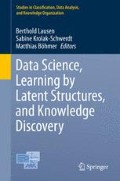Abstract
MicroRNAs (miRNAs) are small RNA molecules that bind messenger RNAs (mRNAs) to silence their expression. Understanding this regulation mechanism requires the study of the miRNA/mRNA interaction network. State-of-the-art methods for predicting interactions lead to a high level of false positive: the interaction score distribution may be roughly described as a mixture of two overlapping Gaussian laws that need to be discriminated with a threshold. In order to further improve the discrimination between true and false interactions, we present a method that considers the structure of the underlying graph. We assume that the graph is formed on a relatively simple structure of formal concepts (associated with regulation modules in the regulation mechanism). Specifically, the formal context topology of true edges is assumed to be less complex than in the case of a noisy graph including spurious interactions or missing interactions. Our approach consists thus in selecting edges below an edge score threshold and applying a repair process on the graph, adding or deleting edges to decrease the global concept complexity. To validate our hypothesis and method, we have extracted parameters from a real biological miRNA/mRNA network and used them to build random networks with fixed concept topology and true/false interaction ratio. Each repaired network can be evaluated with a score balancing the number of edge changes and the conceptual adequacy in the spirit of the minimum description length principle.
Access this chapter
Tax calculation will be finalised at checkout
Purchases are for personal use only
References
Belohlavek, R., & Vychodil, V. (2006). Replacing full rectangles by dense rectangles: Concept lattices and attribute implications. In IEEE Information Reuse and Integration (pp. 117–122). Hawaii: IEEE.
Besson, J., Robardet, C., & Boulicaut, J. F. (2005). Mining formal concepts with a bounded number of exceptions from transactional data. In Knowledge discovery in inductive databases (pp. 33–45). Berlin/Heidelberg: Springer.
Blachon, S., Pensa, R. G., Besson, J., Robartdet, C., Boulicaut, J. F., & Gandrillon, O. (2007). Clustering formal concepts to discover biologically relevant knowledge from gene expression data. In Silico Biology, 7(4), 467–483.
Bryan, K., Terrile, M., Bray, I. M., Domingo-Fernandéz, R., Watters, K. M., Koster, J., et al. (2014). Discovery and visualization of miRNA-mRNA functional modules within integrated data using bicluster analysis. Nucleic Acids Research, 42(3), e17.
Chil, S. W., Zang, J. B., Mele, A., & Darnell R. B. (2009). Argonaute HITS-CLIP decodes microRNA-mRNA interaction maps. Nature, 460, 479–486.
Enright, A. J., John, B., Gaul, U., Tuschl, T., Sander, C., & Marks D. S. (2003). MicroRNA targets in Drosophila. Genome Biology, 5(1), R1.
Gallot, A., Shigenobu, S., Hashiyama, T., Jaubert-Possamai, S., & Tagu, D. (2012). Sexual and asexual oogenesis require the expression of unique and shared sets of genes in the insect Acyrthosiphon pisum. BMC Genomics, 13(1), 76.
Ganter, B., & Wille, R. (1999). Formal concept analysis: Mathematical foundations. Berlin: Springer.
Grimson, A., Farh, K. K. H., Johnston, W. K., Garrett-Engele, P., Lim, L. P., & Bartel, D. P. (2007). MicroRNA targeting specificity in mammals: Determinants beyond seed pairing. Molecular Cell, 27(1), 91–105.
Janga, S. C., & Vallabhaneni, S. (2011). MicroRNAs as post-transcriptional machines and their interplay with cellular networks. In RNA infrastructure and networks (pp. 59–74). New York: Springer.
Klimushkin, M., Obiedkov, S., & Roth, C. (2010). Approaches to the selection of relevant concepts in the case of noisy data. In L. Kwuida & B. Sertkaya (Eds.), Formal concept analysis (pp. 255–266). Berlin/Heidelberg: Springer.
Reyes-Herrera, P. H., Ficarra, E., Acquaviva, A., & Macii, E. (2011). miREE: miRNA recognition elements ensemble. BMC Bioinformatics, 12, 454–473.
The International Aphid Genomics Consortium. (2010). Genome sequence of the pea aphid Acyrthosiphon pisum. PLoS Biol, 8(2), e1000313.
Acknowledgements
This work was founded by ANR project miRNAdapt and Région Bretagne. The authors thank R. Jullien, V. Picard, and C. Galiez for constructive remarks on the paper.
Author information
Authors and Affiliations
Corresponding author
Editor information
Editors and Affiliations
Rights and permissions
Copyright information
© 2015 Springer-Verlag Berlin Heidelberg
About this paper
Cite this paper
Wucher, V., Tagu, D., Nicolas, J. (2015). Edge Selection in a Noisy Graph by Concept Analysis: Application to a Genomic Network. In: Lausen, B., Krolak-Schwerdt, S., Böhmer, M. (eds) Data Science, Learning by Latent Structures, and Knowledge Discovery. Studies in Classification, Data Analysis, and Knowledge Organization. Springer, Berlin, Heidelberg. https://doi.org/10.1007/978-3-662-44983-7_31
Download citation
DOI: https://doi.org/10.1007/978-3-662-44983-7_31
Publisher Name: Springer, Berlin, Heidelberg
Print ISBN: 978-3-662-44982-0
Online ISBN: 978-3-662-44983-7
eBook Packages: Mathematics and StatisticsMathematics and Statistics (R0)

